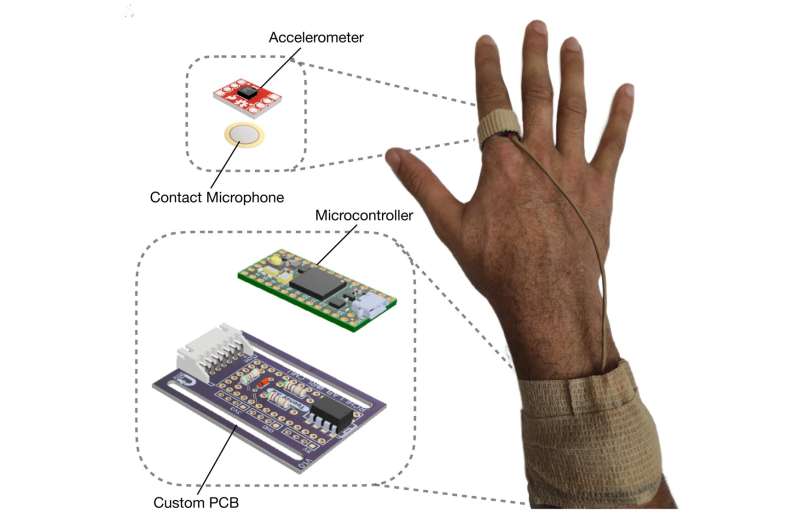This article has been reviewed according to Science X's editorial process and policies. Editors have highlighted the following attributes while ensuring the content's credibility:
fact-checked
peer-reviewed publication
trusted source
proofread
New sensor objectively measures scratching intensity

Akhil Padmanabha knows about itching. His chronic itching caused by severe eczema was so debilitating that he was hospitalized twice and had to be home-schooled during most of his high school years. Itch so impacted his life that, as an undergraduate, he contemplated becoming a psychologist so he could help chronically ill teens facing similar issues.
Instead, he opted to embrace the scalability of robotics and technology. Now a Ph.D. student in Carnegie Mellon University's Robotics Institute, Padmanabha has helped invent a wearable device that can objectively measure the intensity of scratching. As he and his co-investigators explain in the journal Communications Medicine, such a device could help researchers better evaluate the efficacy of medications meant to reduce itching.
Itch is the number one complaint of patients seen by dermatologists, said Dr. Sonal Choudhary, a dermatologist and dermatopathologist at the University of Pittsburgh School of Medicine and a co-author on the study. Eczema alone affects more than 31 million Americans. Psoriasis, allergic reactions and liver disease are among the many other causes of itch.
The idea of measuring the intensity of itch came to Padmanabha while he was perusing research articles on wearable devices.
"I stumbled upon a paper on wearables for scratch detection," said Padmanabha, who recalled that though the device could detect when and how long someone scratched, it was missing a critical component of scratching—intensity. "We really wanted to quantify that intensity of scratching."
As he can personally attest, all scratching is not alike, even if it occurs at the same time of day or in the same place. And the more intense the scratching, the more damage is inflicted on the skin.
Working with Choudhary and his CMU advisors—Zackory Erickson, assistant professor of robotics, and Carmel Majidi, the Clarence H. Adamson Professor of Mechanical Engineering—he devised a device that could be worn like a ring on a scratching finger.
Like previous detection devices, it used an accelerometer to measure finger movement. But while accelerometers can detect some vibrations, they can't pick up the high-frequency ones most associated with scratching. To measure these, the researchers also incorporated a contact microphone, which proved to be key in measuring intensity. The microphone doesn't sense audio. Instead, it detects high-frequency vibrations through solid objects, such as a finger.
"When you're scratching, your finger is actually vibrating," Padmanabha said.
Because the contact microphone can't detect normal sound, its use doesn't pose a privacy concern when worn in public.
The team developed algorithms for the device using data from healthy volunteers who wore it while scratching a pressure-sensitive tablet. The tablet then estimated the scratch intensity in milliwatts. A machine learning algorithm then correlated the raw input from the sensor with the scratch intensity estimates from the tablet. They then converted the scratch intensity to a 0-10 scale that physicians use in practice.
Padmanabha noted that in clinical studies, a change of four units on the 0-10 scale, as reported subjectively by patients, is considered clinically important. The researchers demonstrated that their device had a mean absolute error of 1.37, indicating a precision that would make its readings clinically significant.
They also showed, for the first time, that patients' subjective estimations on the 0-10 scale often markedly differ. For instance, scratch intensity reported by one patient as a 10 might be the equivalent of another patient's 4.
Choudhary, also an assistant professor of dermatology at UPMC, said that once it has been further validated, the device would be most useful to researchers who are testing new drugs and need to precisely determine if they affect itching. It will likely be of less use in clinical medicine, she said, where doctors are used to questioning their patients about their itching symptoms.
But Padmanabha hopes that the device also might be used by doctors and, if not, at least by patients themselves. Sensors, such as smart watches, and computer programs for monitoring personal health are growing in popularity, he noted. In his own case, he has begun wearing a commercially available Oura smart ring, which monitors his activity and vital signs and has caused him to alter his diet, sleep patterns and other factors affecting his health.
Choudhary said there is precedent for the use of such continuous monitoring in clinical medicine, such as glucose monitoring for diabetics. And dermatologists may eventually embrace the information about their patients that a scratch-detection device makes possible. Many itch sufferers certainly have the motivation to undertake such measures.
"They're sometimes desperate to find out what will work," she added.
Padmanabha is seeking research funding to continue work on the device.
"I've worked on various technical projects," he said, "but now, inspired by my personal struggles, I hope to target this thing—itching—that has caused so much suffering in my life."
More information: Akhil Padmanabha et al, A multimodal sensing ring for quantification of scratch intensity, Communications Medicine (2023). DOI: 10.1038/s43856-023-00345-2




















